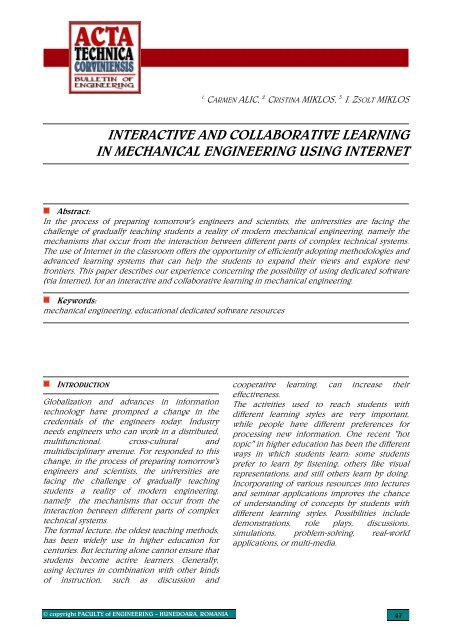ACTA TECHNICA CORVINIENSIS - Bulletin of Engineering
ACTA TECHNICA CORVINIENSIS - Bulletin of Engineering
ACTA TECHNICA CORVINIENSIS - Bulletin of Engineering
- No tags were found...
Create successful ePaper yourself
Turn your PDF publications into a flip-book with our unique Google optimized e-Paper software.
1.CARMEN ALIC, 2. CRISTINA MIKLOS, 3. I. ZSOLT MIKLOSINTERACTIVE AND COLLABORATIVE LEARNINGIN MECHANICAL ENGINEERING USING INTERNETAbstract:In the process <strong>of</strong> preparing tomorrow's engineers and scientists, the universities are facing thechallenge <strong>of</strong> gradually teaching students a reality <strong>of</strong> modern mechanical engineering, namely themechanisms that occur from the interaction between different parts <strong>of</strong> complex technical systems.The use <strong>of</strong> Internet in the classroom <strong>of</strong>fers the opportunity <strong>of</strong> efficiently adopting methodologies andadvanced learning systems that can help the students to expand their views and explore newfrontiers. This paper describes our experience concerning the possibility <strong>of</strong> using dedicated s<strong>of</strong>tware(via Internet), for an interactive and collaborative learning in mechanical engineering.Keywords:mechanical engineering, educational dedicated s<strong>of</strong>tware resourcesINTRODUCTIONGlobalization and advances in informationtechnology have prompted a change in thecredentials <strong>of</strong> the engineers today. Industryneeds engineers who can work in a distributed,multifunctional, cross-cultural andmultidisciplinary avenue. For responded to thischange, in the process <strong>of</strong> preparing tomorrow'sengineers and scientists, the universities arefacing the challenge <strong>of</strong> gradually teachingstudents a reality <strong>of</strong> modern engineering,namely the mechanisms that occur from theinteraction between different parts <strong>of</strong> complextechnical systems.The formal lecture, the oldest teaching methods,has been widely use in higher education forcenturies. But lecturing alone cannot ensure thatstudents become active learners. Generally,using lectures in combination with other kinds<strong>of</strong> instruction, such as discussion andcooperative learning, can increase theireffectiveness.The activities used to reach students withdifferent learning styles are very important,while people have different preferences forprocessing new information. One recent "hottopic" in higher education has been the differentways in which students learn: some studentsprefer to learn by listening, others like visualrepresentations, and still others learn by doing.Incorporating <strong>of</strong> various resources into lecturesand seminar applications improves the chance<strong>of</strong> understanding <strong>of</strong> concepts by students withdifferent learning styles. Possibilities includedemonstrations, role plays, discussions,simulations, problem-solving, real-worldapplications, or multi-media.© copyright FACULTY <strong>of</strong> ENGINEERING – HUNEDOARA, ROMANIA 47
















